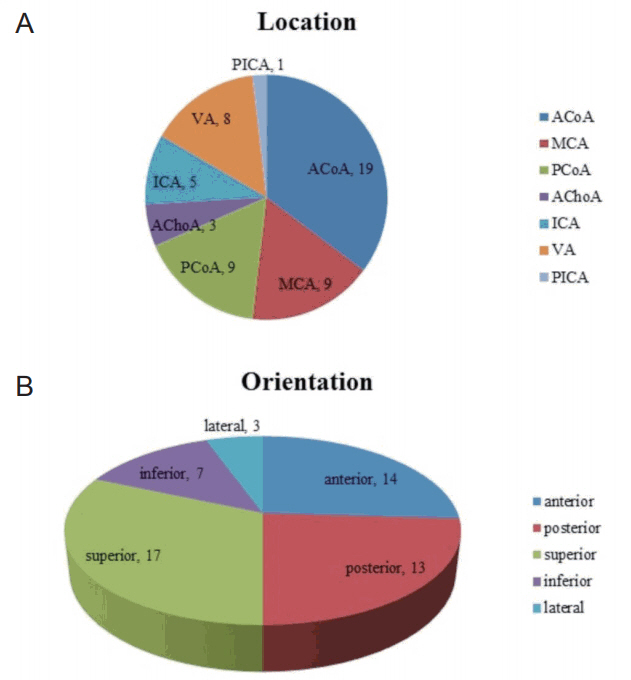J Neurocrit Care.
2017 Dec;10(2):99-106. 10.18700/jnc.170026.
Prognostic Factors Affecting Visual Recovery in Terson Syndrome with Aneurysmal Subarachnoid Hemorrhage
- Affiliations
-
- 1Department of Neurosurgery, Ajou University School of Medicine, Suwon, Korea. nsyclim@gmail.com
- 2Department of Ophthalmology, Ajou University School of Medicine, Suwon, Korea.
- KMID: 2405764
- DOI: http://doi.org/10.18700/jnc.170026
Abstract
- BACKGROUND
The purpose of this study was to survey the anatomical angiographic finding of the aneurysm and identify parameters associated with visual recovery of the patients with Terson syndrome (TS).
METHODS
This retrospective study was conducted on 494 patients with aneurysmal subarachnoid hemorrhage (SAH) from 2008 to 2015. Radiologists independently reviewed findings on computed tomography scans and cerebral digital subtraction angiography. Ophthalmologists conducted ophthalmological examinations for patients who had no communication problem. The degree of visual acuity recovery (DVAR) was measured based on the visual acuity difference between the initial and sixth-month follow-up. Favorable visual recovery was defined as DVAR >0.4.
RESULTS
A total of 494 patients diagnosed with aneurysmal SAH were given admission to a single institute, of whom 171 received ophthalmological examinations. Of the total, 40 patients were diagnosed with TS and 54 eyeballs were affected by vitreous or retinal hemorrhage. In the multivariable analysis, male sex (odds ratio [OR] 9.530; 95% confidence interval [CI] 1.824-49.801), favorable Glasgow coma scale (GCS) (≥13 points) (OR 8.073; 95% CI 1.226-53.148), and anterior orientation of aneurysm (OR 5.006; 95% CI 1.842-29.751) were identified as independent factors predicting favorable visual recovery after adjusting covariables.
CONCLUSION
TS was identified in 23.4% of patients with aneurysmal SAH. Male sex, favorable GCS at admission, and anterior orientation of the aneurysm were identified as prognostic factors for favorable visual recovery. It is proposed that positive ophthalmologic consultation and treatment can be helpful in improving vision and quality of life of TS patients.
Keyword
MeSH Terms
Figure
Reference
-
1. Medele RJ, Stummer W, Mueller AJ, Steiger HJ, Reulen HJ. Terson's syndrome in subarachnoid hemorrhage and severe brain injury accompanied by acutely raised intracranial pressure. J Neurosurg. 1998; 88:851–4.
Article2. Terson PDA. Hemorrhage in the vitreous body during cerebral hemorrhage. La Clin Ophthalmol. 1900; 22:309–12.3. Fountas KN, Kapsalaki EZ, Lee GP, Machinis TG, Grigorian AA, Robinson JS, et al. Terson hemorrhage in patients suffering aneurysmal subarachnoid hemorrhage: predisposing factors and prognostic significance. J Neurosurg. 2008; 109:439–44.
Article4. McCarron MO, Alberts MJ, McCarron P. A systematic review of Terson's syndrome: frequency and prognosis after subarachnoid haemorrhage. J Neurol Neurosurg Psychiatry. 2004; 75:491–3.
Article5. Ness T, Janknecht P, Berghorn C. Frequency of ocular hemorrhages in patients with subarachnoidal hemorrhage. Graefes Arch Clin Exp Ophthalmol. 2005; 243:859–62.6. Manschot WA. Subarachnoid hemorrhage; intraocular symptoms and their pathogenesis. Am J Ophthalmol. 1954; 38:501–5.7. Lee HJ, Kim HC. The clinical outcome and prognostic factors of vitrectomy for macular epiretinal membranes. J Korean Ophthalmol Soc. 2003; 44:857–64.8. Jeong JH, Chun YS, Kim JC. The effects of a subtenoncapsular injection of bevacizumab for ocular surface disease with corneal neovascularization. J Korean Ophthalmol Soc. 2009; 50:1475–82.
Article9. Espinasse-Berrod MA, David T, Parent DCH, Mayer JM, Deplus S, Merland JJ, et al. Terson's syndrome. About of 7 cases. J Fr Ophtalmol. 1988; 11:43–51.10. Shaw HE Jr, Landers MB 3rd. Vitreous hemorrhage after intracranial hemorrhage. Am J Ophthalmol. 1975; 80:207–13.
Article11. Toosi SH, Malton M. Terson's syndrome--significance of ocular findings. Ann Ophthalmol. 1987; 19:7–12.12. Garfinkle AM, Danys IR, Nicolle DA, Colohan AR, Brem S. Terson's syndrome: a reversible cause of blindness following subarachnoid hemorrhage. J Neurosurg. 1992; 76:766–71.
Article13. Vanderlinden RG, Chisholm LD. Vitreous hemorrhages and sudden increased intracranial pressure. J Neurosurg. 1974; 41:167–76.
Article14. Frizzell RT, Kuhn F, Morris R, Quinn C, Fisher WS 3rd. Screening for ocular hemorrhages in patients with ruptured cerebral aneurysms: a prospective study of 99 patients. Neurosurgery. 1997; 41:529–33. discussion 533-4.
Article15. Kuhn F, Morris R, Witherspoon CD, Mester V. Terson syndrome. Results of vitrectomy and the significance of vitreous hemorrhage in patients with subarachnoid hemorrhage. Ophthalmology. 1998; 105:472–7.16. Pfausler B, Belcl R, Metzler R, Mohsenipour I, Schmutzhard E. Terson's syndrome in spontaneous subarachnoid hemorrhage: a prospective study in 60 consecutive patients. J Neurosurg. 1996; 85:392–4.
Article17. Roux FX, Panthier JN, Tanghe YM, Gallina P, Oswald AM, Mérienne L, et al. Terson's syndrome and intraocular complications in meningeal hemorrhages (26 cases). Neurochirurgie. 1991; 37:106–10.18. Tsementzis SA, Williams A. Ophthalmological signs and prognosis in patients with a subarachnoid haemorrhage. Neurochirurgia (Stuttg). 1984; 27:133–5.
Article19. Doubler FH. A case of hemorrhage into the optic nerve sheath as a direct extension from a diffuse intra-meningeal hemorrhage caused by rupture of an aneurysm of a cerebral artery. Arch Ophthalmol. 1917; 46:533–6.20. Shaw HE Jr, Landers MB, Sydnor CF. The significance of intraocular hemorrhages due to subarachnoid hemorrhage. Ann Ophthalmol. 1977; 9:1403–5.21. Czorlich P, Skevas C, Knospe V, Vettorazzi E, Richard G, Wagenfeld L, et al. Terson syndrome in subarachnoid hemorrhage, intracerebral hemorrhage, and traumatic brain injury. Neurosurg Rev. 2015; 38:129–36. discussion 136.
Article22. Koskela E, Pekkola J, Kivisaari R, Kivelä T, Hernesniemi J, Setälä K, et al. Comparison of CT and clinical findings of Terson's syndrome in 121 patients: a 1-year prospective study. J Neurosurg. 2014; 120:1172–8.
Article
- Full Text Links
- Actions
-
Cited
- CITED
-
- Close
- Share
- Similar articles
-
- Terson Syndrome in Aneurysmal Subarachnoid Hemorrhage: A Case Report
- Terson's Syndrome in Aneurysmal Subarachnoid Hemorrhage
- Terson's Syndrome due to Subarachnoid Hemorrhage after Rupture of MCA Bifurcation Aneurysm
- Practical Incidence and Risk Factors of Terson's Syndrome: A Retrospective Analysis in 322 Consecutive Patients with Aneurysmal Subarachnoid Hemorrhage
- Incidence and Postoperative Visual Outcome of Terson's Syndrome


